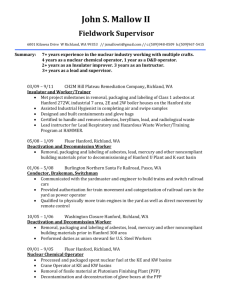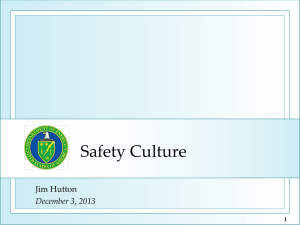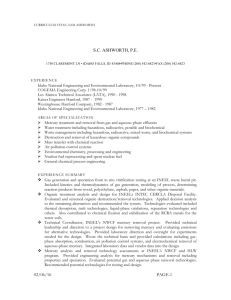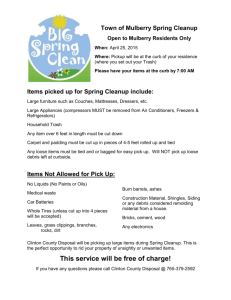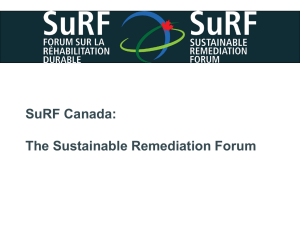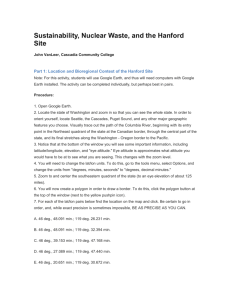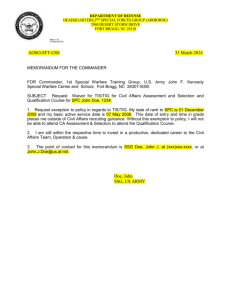Contested Meanings of Environmental Remediation
advertisement
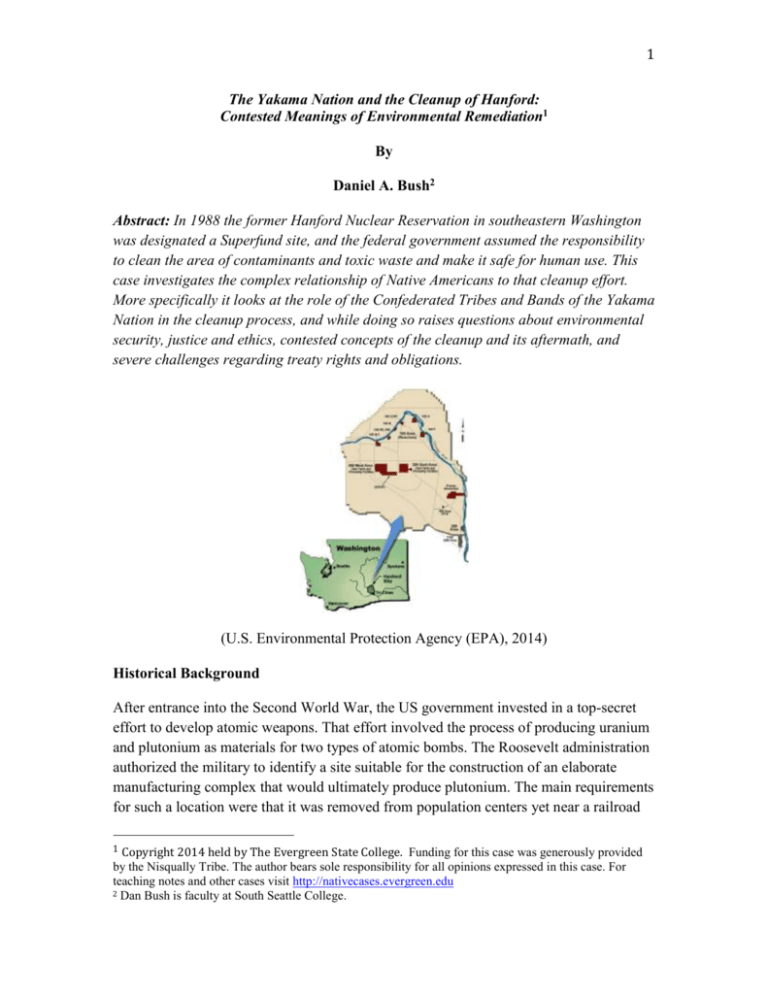
1 The Yakama Nation and the Cleanup of Hanford: Contested Meanings of Environmental Remediation1 By Daniel A. Bush2 Abstract: In 1988 the former Hanford Nuclear Reservation in southeastern Washington was designated a Superfund site, and the federal government assumed the responsibility to clean the area of contaminants and toxic waste and make it safe for human use. This case investigates the complex relationship of Native Americans to that cleanup effort. More specifically it looks at the role of the Confederated Tribes and Bands of the Yakama Nation in the cleanup process, and while doing so raises questions about environmental security, justice and ethics, contested concepts of the cleanup and its aftermath, and severe challenges regarding treaty rights and obligations. (U.S. Environmental Protection Agency (EPA), 2014) Historical Background After entrance into the Second World War, the US government invested in a top-secret effort to develop atomic weapons. That effort involved the process of producing uranium and plutonium as materials for two types of atomic bombs. The Roosevelt administration authorized the military to identify a site suitable for the construction of an elaborate manufacturing complex that would ultimately produce plutonium. The main requirements for such a location were that it was removed from population centers yet near a railroad 1 Copyright 2014 held by The Evergreen State College. Funding for this case was generously provided by the Nisqually Tribe. The author bears sole responsibility for all opinions expressed in this case. For teaching notes and other cases visit http://nativecases.evergreen.edu 2 Dan Bush is faculty at South Seattle College. 2 and most important an abundant supply of fresh water to cool the massive heat generated by the chemical reactions that would take place inside the reactor. In early 1943, American military officials chose a site in southeastern Washington State. Some fifteen hundred inhabitants, mostly farmers in the area, were forced to relocate, and Native American access was restricted. Thousands of workers were brought in to construct and operate the Hanford Nuclear Reservation that went on to produce plutonium not only for the atomic bomb dropped on Nagasaki in 1945, but also for the development of a nuclear arsenal over the next several decades during the Cold War. By the 1980s, it became clear that activities at Hanford had left a legacy of environmental degradation that led to an ongoing, costly, and incredibly complex effort to clean up “the most contaminated site in the Western Hemisphere” (Physicians for Social Responsibility, 2014, para. 1). The production of plutonium was a complex process that also created a host of hazardous materials including radioactive wastes that pose a danger to the environment for thousands of years. Moreover, contamination was not limited to the Hanford site itself. While radioactive wastes were systematically stored on the site, over the course of several decades leading up to the cleanup effort, contaminants were also released and leaked into the surrounding environment. Human exposure to dangerous elements spread over a wide area in and around Hanford. It is estimated that “nearly 2 million individuals were exposed to a total of 237 varying radionuclides released into the air pathway or through the Columbia River pathway from 1944 to 1972” (Safe As Mother’s Milk, 2012, para. 1). For much of that time, federal authorities did little to alert those living in and using the area where there was growing toxicity of the environment. According to Nez Perce elder Veronica Taylor, who was a youth during the early days of Hanford, “We didn’t know too much about the radiation that was coming from this Hanford area until much later” (Taylor, 2003). Gradually however, public awareness of the toxicity from Hanford emerged and Native American elders began warning of the dangers of consuming contaminated fish and “bad animals” from Hanford (Taylor, 2003). Historically, the Columbia River has been the main artery for sustenance in the region. Yet as a result of the Hanford Nuclear Reservation “people received exposure [to toxic substances] from the Columbia River by: eating contaminated fish and seafood; drinking contaminated water; swimming in or boating on the Columbia River; standing along the river shoreline or on a lawn irrigated with river water; and breathing dust blowing off exposed beaches or land irrigated with river water” (Washington Nuclear Museum and Educational Center (WANMEC), n.d., para. 5). Known as “downwinders,” those exposed have faced major resistance from federal authorities to officially recognize illnesses and conditions contracted through that exposure (WANMEC). Due to the large amount of fish in their diets, Native Americans in particular face the challenges of dealing with 3 environmental poisoning from Hanford (Tolson, Yakima Fights, 2014).3 To avoid conditions contracted from consuming contaminated foods such as salmon, Native peoples have already altered their traditional diets. The consequences of those changes are many, including increased incidences of diabetes among tribal members (Tolson, Restoring, 2014). The issue here is “food sovereignty,” which involves “having control of native food systems”; “‘if you lose your foods, you lose part of your culture – and it has a devastating effect on the psyche,’ says a Yakama nurse in a recent report” (Tolson, Restoring, 2014). Map: Groundwater Contamination 2014 (Daily Kos, 2014). Cleanup In response to growing public concerns over hazardous wastes sites throughout the country, Congress passed the Comprehensive Environmental Response, Compensation, and Liability Act (CERCLA) in 1980. CERCLA authorized the federal government to collect and allocate resources into a Superfund to clean up toxic areas that pose a threat to public health. In 1988 Hanford was placed on the National Priorities List as a Superfund site (EPA, Hanford Superfund Site History, 2014). Contamination from the Hanford Nuclear Reservation is spread over a wide area that includes the 586 square mile area of the Hanford site itself, the Columbia River system, and the soil, water, flora, animals, and in some cases humans in the surrounding region. Contaminants have been released onto 3 See Salmon and Contamination in the Columbia River by Lori Lambert at http://nativecases.evergreen.edu/collection/cases/salmon-and-contamination.html. The Yakima Nation is often referred to by the more traditional name Yakama. 4 the site and the surrounding area for several decades and continue to pose an environmental threat to human and ecological health. In 1989, the Department of Energy (DOE), the Environmental Protection Agency (EPA), and the State of Washington Department of Ecology signed a Tri-Party Agreement that allocated responsibility for restoration of the site and an “action plan” for what has become the world's largest environmental cleanup project. The contaminants come in many forms, pose various levels of risk, and call for a complex array of technologies in the cleanup effort. Though contaminants are spread across the site, the levels of toxicity vary from location to location. For more than two decades, DOE contractors have been demolishing buildings, disposing of wastes, monitoring water tables, and have plans to address the issue of highly toxic materials leaking from underground waste storage tanks.4 The overall plan is predicated on the assumption that the cleanup will result in “remediation” of the Hanford site.5 The 1989 Agreement also ordered that the cleanup effort be transparent and allow for public involvement. The DOE has identified “stakeholders,” many who are involved in educating the public on the cleanup effort (Washington State Dept. of Ecology, n.d.). DOE public relations efforts include public tours given of the Hanford site. While most of the reactors have been “cocooned,” the BReactor has been designated a National Historic Landmark, and tours give an inside look at the reactor core (Wikipedia, B-reactor, 2014). Though the tours focus on the site’s contributions to national security, by inference public tours help to promote the sense that perhaps with some precautions, the Hanford site is not dangerous to the general public. Nevertheless, despite the appearance of a systematic and controlled cleanup, there has been growing concern over the DOE’s commitment to meeting remediation expectations. Figure 1 B-Reactor (Wikipedia) 4 Figure 2 B-Reactor Core (photo taken by D. Bush) A comprehensive listing of contaminants at Hanford can be accessed at http://www.hanfordchallenge.org/the-big-issues/hanfords-reach/. A listing of contaminants in the groundwater is at http://www.ecy.wa.gov/programs/nwp/gwhanfordcont.htm 5 Remediation is the process of correcting a problem—application of a remedy. In many cases, it refers to the cleaning of a pollutants and toxins from the environment. http://en.wikipedia.org/wiki/Environmental_remediation 5 Figure 3 Looking out of B-Reactor (Bush) Figure 4 View from Tour Bus (Bush) Over the past few years, the Washington State Department of Ecology and the state’s attorney general have issued several complaints about DOE violations of the Tri-Party Agreement. Many of those charges relate to the failure of the DOE to meet scheduled timetables for the cleanup of Hanford. Plans to construct and begin operation of a Waste Treatment Plant (WTP) by 2011 have not been met. The plant is supposed to transform high level radioactive wastes stored in unstable tanks into a more stable form for later disposal, but construction has been stalled due to a variety of issues including the reliability of the technology and costs (Johnson, 2014). Moreover, original plans to ship wastes out of state have been shelved, so at present there is no site available to store contaminants from Hanford. The state of Washington has been particularly alarmed over leakage of radioactive wastes from underground storage tanks migrating into the ground water and ultimately into the Columbia River (Ferguson, 2014). Concerns over leaking tanks and missed cleanup commitments surfaced as early as 2008, which led to a new schedule for the cleanup validated by a federal judge in 2010. The new agreement stipulated the following: Pacing milestones to keep construction of the WTP on schedule Completion of the retrieval of single-shell tanks in Hanford’s C Farm in 2014 Treatment of tank waste beginning in 2019 with full operations in 2022 Completing the retrieval of all single-shell tanks in 2040 Completing the treatment of tank waste in 2047 Closing the double-shell tank farms in 2052 (Ferguson, 2014) While the issue of waste retrieval, treatment and re-storage highlights difficulties that the DOE has had in meeting those commitments to the state of Washington, the target dates 6 of the recent agreement only hint at the length of time involved in the cleanup effort. Despite its concerns the state of Washington appeared confident that the cleanup would be successful as former Governor Christine Gregoire assured the public that “the Columbia River—and a million people who live and work downstream from Hanford— will be protected from contamination” (Gregoire, 2010, para. 3). Nevertheless, assuming the health of workers at Hanford is included in that concern, the former governor’s assurance does not necessarily fit with how the Department of Energy has overseen the cleanup effort itself. According to one study, the relationship between the DOE and Hanford workers reflects “a deeply unequal power structure at Hanford. Risk and nuclear safety are managed in such as way on site that the burden of responsibility for accidents often falls on workers’ shoulders, rather than on the officials who approved the procedure. It also reflects a governmental fiction that risk-free nuclear management is possible” (Cram, 2011). Environmental and health risks are of particular concern to Native Americans in the region. Through traditional use of natural resources, including salmon runs in the Columbia River system, Native Americans have been dealing with contaminants from Hanford for several decades. Treaties that ceded the Hanford region to the federal government in 1855 also retained Native rights to use the area for hunting, fishing, gathering and for cultural practices. In cases of environmental degradation, the treaties further established the basis for a relationship between Native Americans and federal authority, where the federal government has an obligation to protect natural resources used by affected Tribes. Several laws, policy rules, and orders have only served to affirm that responsibility6 and executive departments and agencies have been reminded on several occasions of the importance of working cooperatively with Native Americans in Superfund areas. 6 Examples include the Tribal Preservation Program overseen by the National Park Service as ordered by the National Historic Preservation Act (http://www.nps.gov/tribes/Tribal_Historic_Preservation_Officers_Program.htm); and President Bill Clinton’s 1994 memorandum on government-to-government relations with Native Tribes (http://www.dot.gov/sites/dot.dev/files/docs/Govt%20to%20Govt%20Relations%20w%20Native %20Am%20Tribal%20Govts.pdf); and Executive Order 13175 “Consultation and Coordination With Indian Tribal Governments,” dated 11/06/2002 (http://ceq.hss.doe.gov/nepa/regs/eos/eo13175.html); and the Environmental Protection Agency publishes “Consulting with Indian Tribal Governments at Superfund Sites: A Beginner’s Booklet at http://www.epa.gov/superfund/partners/osrti/booklet_text.htm 7 Map: Yakama Reservation and lands ceded by the Yakama in the 1855 treaty (Klickitat Library Images, 2014) According to the DOE’s Tribal Program, “the involvement [of] Native American Tribes at Hanford is guided by DOE's American Indian Policy [which] states that it is the trust responsibility of the United States to protect tribal sovereignty and self-determination, tribal lands, assets, resources, and treaty and other federal recognized and reserved rights” (Department of Energy (DOE) Tribal Program, 2014). Therefore, where Native Americans are concerned it would seem that the DOE has a legal obligation to restore the Hanford site to its pre-nuclear state. It could also be argued that Native tribes have their own trust responsibility for preservation of natural resources on both tribal lands and those areas of traditional use. Moreover, the web of responsibilities associated with the Hanford cleanup are complicated by potential liabilities, as Native peoples have a right to “damages for injuries which occur to natural resources as a result of hazardous waste release” (Bauer, 1994). Thus, Native Americans who traditionally used the affected area have also been involved in the cleanup of Hanford. CERCLA itself named Native tribes as having a vested interest in Superfund sites such as Hanford. The DOE agrees that the Nez Perce Tribe, the Confederated Tribes of the Umatilla Indian Reservation, the Confederated Tribes and Bands of the Yakama Indian Nation, and Wanapum native peoples be regularly consulted throughout the cleanup process and that all have rights to resources in the Hanford region. In recognition of those rights, the “DOE provides financial assistance through cooperative agreements with the Yakama Nation, Confederated Tribes of the Umatilla Indian Reservation, and the Nez Perce Tribe to support their involvement in environmental management activities of the Hanford Site” (Clarke, 2004, p. 2). However, the consultation process essentially means that the DOE decides on a course of action, and then submits that to the Tribe for comments, which are then shelved while the DOE 8 pursues the course of action without regard to Native comments or concerns (Jim, Talking Stick, 2001). Native Americans are supportive of the cleanup and would like to see the complete restoration of the affected areas to their pre-nuclear conditions, but the DOE has been unwilling to regard the affected Tribes as partners in that effort (Nez Perce, 2005). Indeed, it is also “clear that residual contamination will remain on site and will preclude unrestricted future access to cultural resource sites and traditional land use activities creating long-term responsibilities” (Baptiste, 2005). While the consultation process between the DOE and the affected Tribes may be fictional, there is also fundamental disagreement over what remediation actually means.7 The DOE represents non-native approaches to natural resources. With the first permanent landing of Europeans in North America, non-native Americans regarded the environment as a frontier, something to be brought under control, transformed, and made suitable for economic development. In the early 20th century, an environmental awareness emerged that sought to either conserve natural resources for “sustainable use,” or preserve them for aesthetic and recreational use. While sustainability equated forests with agriculture, which required cutting and replanting trees into new managed forests, a process that permanently alters ecosystems, preservation placed other areas into outdoor museums, such as National Parks, for recreational purposes. According to Chris Pineo, who sees Hanford as a “conflicted . . . landscape,” “an official video by the US Department of Energy promotes a continued ‘frontier’ myth at Hanford” (2012). The aim may be remediation but once complete, Hanford will likely not be a place that DOE officials and contractors will call home. For Native Americans, the environment is not a place to transform or visit. Though use and sustainability are important, Native Americans also have cultural and spiritual relationships to the environment and the natural resources it contains. The fishing, hunting, and gathering that Native Americans have engaged in for centuries helped to sustain native peoples and perpetuate their cultural and spiritual traditions. For example, the Hanford region contains sacred native burial sites, and specific landscape formations are part of their cultural history (Cary, 2014). Therefore, non-native use of those areas can pose a threat to the affected Native peoples. For Native Americans, the Hanford region is much more than a place to be cleaned, transformed and processed for other use. Essentially, it is home. 7 The International Atomic Energy Agency may be representative of the riddles involved in environmental remediation, stating that, “returning a contaminated site to its original state is often neither necessary nor possible. While environmental remediation aims to reduce radiation exposure to protect people, remediated sites can still be used for various purposes, for example, industrial operations and even housing.” http://www.iaea.org/OurWork/ST/NE/NEFW/_nefwdocuments/Environmental_Remediation.pdf 9 Long Term Stewardship The DOE asserts that the cleanup is progressing at a reasonable pace and predicts that remediation of Hanford is an achievable goal. However, for the DOE, cleanup does not necessarily mean an area completely safe for humans. According to the DOE, “because the completion of cleanup will not result in the total elimination of all contamination (radiological and/or hazardous), long-term stewardship activities will be required for portions of the Hanford Site to ensure protection of human health and the environment” (DOE, Cleanup Completion Framework, 2013). Essentially then, as the Department declares particular areas of the cleanup complete, it enters them into a finalization phase, known as the Long-Term Stewardship (LTS) program. LTS “refers to all activities necessary to ensure protection of human health and the environment following completion of cleanup, disposal or stabilization of a site,” and promises to manage the “cultural, biological and natural resources” of the several areas of the Hanford site that have completed the initial cleanup (DOE, What is Long Term Stewardship? (LTS), 2014). LTS also involves “information management,” which refers to the appropriate transfer of accurate information about the cleaned areas to those who use area resources, and live and work in the area. It seems that while LTS involves a variety of on-site activities including monitoring, controlling access to and information about the site, it essentially marks an end of any concerted cleanup effort. Therefore, execution of the LTS program involves management of biological and cultural resources as well as controlling how the public understands post-cleanup Hanford (DOE, LTS Execution, 2014). For affected Native tribes, LTS is problematic. For example, the Yakama have little confidence that LTS will achieve its stated goals. There may also be some trepidation that LTS merely masks the reality that these areas are not genuinely clean. The Yakama assert that the cleanup be based on proven technology and that the eventual outcome of the cleanup is that Hanford and the surrounding region be safe for all traditional uses by the Tribe. While the DOE seems confident that post-cleanup efforts will “protect human health and the environment” (DOE LTS Execution, 2014), the Yakama are skeptical that LTS is a viable program for a region that will “remain dangerous for hundreds or thousands of years” (George and Jim, 2013). 10 Map: LTS Transition Segments 1,2,3, 5 and 100-F have been placed into Long Term Stewardship as of 2014. (DOE, LTS Transition, 2014) The LTS program at Hanford exposes fundamental tensions inherent in federal responsibility toward the Tribes. The DOE professes an unequivocal commitment to preserving Native rights and treaty obligations, but it is unclear if the DOE’s interpretation of those rights and obligations is in line with that of the Tribes in the region. Native groups not only hold to a strict reading of those commitments, but also are unequivocal that the federal government meet its obligations completely in every respect. Though both parties are in agreement that an obligatory commitment exists, the DOE may be guilty of managing that commitment to fit with their cleanup goals. For the time being, however, rather than engage in open dispute, all parties “’have agreed . . . that each . . . reserves the right to assert its respective interpretation of treaty rights at Hanford” (Baptiste, 2005). Complete restoration of the Hanford region is likely not achievable anytime into the foreseeable future, a reality that may be incompatible with expectations toward a postcleanup Hanford. It may be the case that the DOE is committed to protecting Native resources at Hanford, but that a full commitment to that protection is not achievable under current federal plans for the site. For the DOE, the LTS program will lead to the transfer of Hanford “to another federal or nonfederal agency,” thus absolving the department of further responsibility for Hanford and by implication further responsibility to the affected Native tribes. Where Native Americans are concerned, a post-cleanup Hanford poses issues of environmental security and justice. Because the area will remain contaminated even after remediation is complete, the cleanup and the LTS program to follow will not enable the Yakama to resume their accustomed activities in the “cleaned” areas. 11 It is difficult for Native Americans to accept the reality that Hanford may never be completely safe for human use. According to Yakama elder Russell Jim, acceptance of “a permanent legacy of contamination and damaged resources” at Hanford is not a feasible option (Jim, Heart of America Northwest, 2007, p. 4). Acceptance implies giving up and not continuing the cleanup effort. Moreover, it could also undermine a fundamental principle in the relationship between Native tribes and the federal government, which obligates federal authorities to protect Native Americans from the environmental degradation of areas they rightfully use. The poisoning of Hanford does not relieve the federal government of this obligation, but admission by the Yakama that the area is not redeemable for full human use may absolve federal authorities from attempting further cleanup of Hanford; it could also send the unwanted message that in some cases Native tribes are willing to accept something less than complete protection of their resources. Despite its claim to protect Native American rights to resources, the DOE also tacitly admits that remediation of Hanford may not be not possible for several reasons. At present, neither the DOE nor any of the stakeholders have the technical ability to undo the toxic legacy of the Hanford site. The cost of the cleanup is another obstacle to this goal. But rather than openly confess that achieving complete environmental safety at Hanford is unlikely, the DOE instead has sought to control key concepts and responsibilities associated with its role in the cleanup. The DOE offers its own definition of “cleanup” itself while asserting its own interpretation of its obligations toward Native American treaty rights. By controlling what cleanup actually means, the DOE can claim that the federal government has completed its responsibility toward those who will continue to be adversely affected by the contamination at Hanford—both Native and nonnative. In essence, the DOE has defined environmental remediation at Hanford to actually mean partial restoration in order to accomplish its stated objectives as well as adhere to their obligation to protect Native resources, while leaving residents in the region and Native Americans like the Yakama to struggle with the continuing toxic legacy of Hanford. Case Questions What is the position of the affected Tribes toward the cleanup and the LTS program? What is the role of treaty rights and obligations in the cleanup of Hanford? Should the Yakama pursue a more adversarial position vis a vis the DOE and continue to insist on the complete restoration of the Hanford site, even in the face of the reality that that goal may be impossible to achieve? If so, what avenues of pressure can the Yakama bring to bear on the DOE? 12 Should the Yakama join with other affected Native Americans to continue to seek litigation that would compel the DOE to adjust its interpretation of treaty rights in the Hanford area, even if that means the cleanup effort would continue indefinitely? Should the Yakama Nation readjust its expectations at Hanford, and if so, what might be the nature of that adjustment? Should the Yakama trust that the DOE’s efforts, using currently technology, are all that can be hoped for and concentrate its efforts on educating its members on safe and limited use of the Hanford area? 13 References Baptiste, K. L. (2005). “Final Report: Hanford Tribal Stewardship." Retrieved from http://www.clarku.edu/mtafund/prodlib/nez_perce/hanford_tribal_stewardship.pdf Bauer, M. (n.d.). “Tribal Involvement at Department of Energy Sites Through the Authority of CERCLA Natural Resources Trusteeships.” Retrieved from http://www.wmsym.org/archives/1994/V2/106.pdf Cary, A. (2014). “Yakama File Suit to Stop Rattlesnake Wildflower Tours.” Tri-City Herald. Retrieved from http://www.tricityherald.com/2014/04/23/2940536/yakamas-file-suit-to-stop-rattlesnake.html Clarke, K. V. “The Role of Indian Tribes.” Public Involvement at Hanford, Retrieved from http://hanford-site.pnnl.gov/envreport/2004/15222/15222-2.pdf Cram, S. (2011). “Escaping S-102: Waste, Illness, and the Politics of Not Knowing.” International Journal of Science and Society 2 : 243-252. p. 245 Daily Kos. Retrieved from http://images2.dailykos.com/images/user/14898/hanford_groundwater_ large.jpg Department of Energy. Hanford Site: Cleanup Completion Framework, Dec. 2012. Retrieved from http://www.hanford.gov/files.cfm/Hanford_Site_Cleanup_Completion_ Framework_DOE_RL-2009-10_Rev1.pdf Department of Energy. LTS Execution, 2014. Retrieved from http://www.hanford.gov/page.cfm/LTSExecution Department of Energy. LTS Transition, 2014. Retrieved from http://www.hanford.gov/page.cfm/LTSTransition Department of Energy (DOE) Tribal Program. Retrieved from http://www.hanford.gov/page.cfm/INP Department of Energy. What is Long Term Stewardship, 2014. Retrieved from http://www.hanford.gov/files.cfm/What_is_LTS_rv4_2014.pdf Environmental Protection Agency, Hanford Superfund Site History, 2014. Retrieved from 14 http://yosemite.epa.gov/R10/CLEANUP.NSF/0/045F8399CAA1B6BD882573FC 0069B078?OpenDocument Ferguson, B. (2014). Attorney General of Washington to US Dept. of Justice. Retrieved from http://www.ecy.wa.gov/news/2014/docs/20140331StateProposal-CvrLtr.pdf Ferguson, B. Washington State Attorney General press releases. Retrieved from http://www.atg.wa.gov/pressreleases.aspx?topic=Energy#.U_DwsIBdUzl http://www.atg.wa.gov/pressrelease.aspx?&id=31022#.U-wTEIBdUzI George, M. and R. Jim, (2013). Response from Confederated Tribes and Bands of the Yakama Nation. Retrieved from http://pdw.hanford.gov/arpir/pdf.cfm?accession=1401080132 International Atomic Energy Agency, (n.d). Retrieved from http://www.iaea.org/OurWork/ST/NE/NEFW/_nefwdocuments/Environmental_Remediation.pdf Jim, R. (2007). “The Yakama Nation & Restoration of the Hanford Site.” Retrieved from hoanw.org/russell%20jim%20speech.doc Jim, R. (2003). TalkingStickTV - Russell Jim - Nuclear Attack on the Yakama Culture. Retrieved from http://www.youtube.com/watch?v=wTLCSFN2fH4 Johnson, B. (2014). Docent for Hanford B-Reactor Tour. Comments to author, 23 July 2014. Klickitat Library Images. Retrieved from http://ykfp.org/klickitat/Library/images/maps/cededlands_map.jpg Nez Perce Hanford End-State Vision Resolution NP-05-411. (September 27, 2005). Retrieved from http://cybercemetery.unt.edu/archive/brc/20120621062120/http://brc.gov/sites/def ault/files/meetings/attachments/nez_perce_end_state_vision_amended.pdf Pineo, C. In the Garden of the Apocalypse: Narrating Myth and Reality in the Hanford Landscape, pp. 18-19. Thesis submitted in partial fulfillment for Masters in Architecture at the University of Washington, 2012. Retrieved from https://digital.lib.washington.edu/researchworks/handle/1773/22670 Physicians for Social Responsibility. Hanford Facts, 2014. Retrieved from http://www.psr.org/chapters/washington/hanford/hanford-facts.html Safe as Mother’s Milk. (2012). Retrieved from http://www.hanfordproject.com/downwinders.html 15 Taylor, Veronica. (2003). Interview, in the Voices of Manhattan Project, Sept. 2003. Retrieved from http://www.manhattanprojectvoices.org/oral-histories/veronicataylors-interview Tolson, M. (2014). “Yakama Fights for Nuclear Waste Cleanup at Hanford Site.” Earth Island Journal. Retrieved from http://www.earthisland.org/journal/index.php/elist/eListRead/yakama_nation_figh ts_for_nuclear_waste_cleanup_at_hanford_site/ Tolson, M. (2014)“Restoring First Foods to the Columbia River Basin.” The WIP. Retrieved from http://thewip.net/2014/06/12/restoring-first-foods-to-thecolumbia-river-basin/ Wikipedia. “B Reactor.” (2014). Retrieved from http://en.wikipedia.org/wiki/B_Reactor#Current_status
